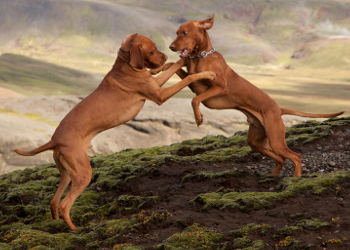Overweight Pets- A National Disaster11 min read
OVERWEIGHT PETS LUMBER ALONG
It never used to be that way. People and their companion animals never lived hectic lives like they do today. Obesity in the human population is paralleled by overweight pets. Many medical problems in pets can be traced back to a poor diet and lack of physical exercise. Over time this leads to obesity. Animals just don’t become overweight overnight. Dogs and cats are much smaller than humans. A one pound weight gain may be negligible in people but in pets it can be dramatic. A pound here and a pound there add up over time. There is one simple rule to follow if you want to maintain or lose weight. Calorie intake has to be equal to or less than calorie expenditure. Any excess caloriesSome carbohydrates are converted to glycogen; a quick source of calories for the body that are stored in the liver and muscle tissues. Glycogen is involved in the famous "fight or flight" mechanism hard-wired into all mammals. Glycogen is then converted to adrenalin which gives mammals that ability to fight or flee! will be processed to fat in the liver. That fat then clogs liver cells, arteries, pulmonary and abdominal spaces and so on.
There are numerous factors that lead up to obesity. The majority of dogs and cats that are neutered become overweight. This is especially true of spayed females. These animals become more sedentary and tend to lounge around the home after neutering. This is hormonal due to the loss of estrogenThe majority of estrogen in the female mammal is produced in the ovaries. A small amount of estrogen is also produced in the adrenal glands. Males also produce estrogen in their adrenal glands but the amount produced is minimal so as to not produce feminization traits such as breast development.. Intact animals spend a tremendous amount of calories going in or out of heat. Pregnancy also requires intense caloric needs. When a dog or cat is spayed that supply of estrogen goes bye bye. In medicine there is always a pro and a con to many procedures. There are tremendous benefits to neutering but spaying females predisposes them to obesity and urinary incontinence as they age.
Overweight pets often have genetics to blame for their condition. There are handfuls of dog breeds that are prone to obesity. The Pug, Labrador Retriever, Dachshund, Beagles and others are prone to weight gain. Many large breed female dogs are often presented with a flat like back appearance. I used to call them walking coffee tables.
Then there is cold, snowy weather up north in the winter that leads to obesity. Animals have to eat more to burn enough calories to stay warm when it is cold outside. Their appetites are always primed. The problem is that very few people want to exercise their pets when it is cold outside so the animals, like their owners, become sedentary in the winter. This leads to weight gain.
THE EFFECTS OF EXCESSIVE WEIGHT
Overweight pets are predisposed to a myriad of medical problems. Excess body fat is deposited all over the place in the body! Much of that fat is deposited as abdominal fat. If owners could only see what the abdominal contents of an obese animal looked like they would be in shock. It is not a pretty sight. Surgical procedures often take longer with all the abdominal fat in the way. Ligatures (sutures) often slip since blood vessels are coated with slippery fat residue. This prolongs surgery time. Overweight pets also dehydrate more quickly. They contain about 10-15% less water than a trim animal. In an older dog or cat this can make renal (kidney) disease worse.
Body fat does serve a purpose. Per gram it contains four times the calories as protein or carbohydrates. In a cold climate living off “the fat”, within reason, is a fair idea. It also insulates the body. Like most everything else in life it is the excess that gets animals in to trouble.
Overweight pets are predisposed to Diabetes mellitus. The only function of insulin is to facilitate the transfer of glucose into a cell. When the space between cells is clogged with fat insulin doesn’t work as well. This leads to elevated blood sugar. Dogs and cats are placed on insulin injections twice daily.
Overweight pets are also prone to liver and heart disease. Fat depositions in the liver inhibit normal biochemical processes. The liver is the body’s factory. When the conveyor belt in the liver is clogged with fat it can’t function properly. With cats this is a big problem. Cats that are overweight for a long period of time or do not eat for 3 days or more are at a huge risk of fatty liver disease (hepatic lipidosis). It is almost always fatal. The heart is also affected. All of this extra fat requires blood vessels to nourish them. This puts an excessive strain on the cardiovascular system.
One of the most common medical problems associated with overweight pets is an early onset of arthritis. Excessive weight puts a strain on multiple joints of the body. The most affected are the: hip joint, lumbar vertebrae and the forelimbs. A young animal may be able to compensate for excess weight but as an animal ages its joint surfaces wear down. Arthritis is exacerbated in overweight pets. This gets back to the big difference between a one pound gain in a average size dog or cat compared to that of a human. I always kept a small 3 pound brick in a cabinet in my exam rooms. If I detected a pet was several pounds overweight I handed the brick to the owner. They acted like it was heavy. It was! This is the extra weight the pet is carrying around. It put things into perfect perspective.
SOLUTIONS
It is fantastic watching a dog or cat lose weight over time. An animal that has lost weight has so much more energy and is able to exercise much longer than overweight pets! It is a positive vicious circle. The more weight the animal loses the more energy it has to exercise without getting winded or tired. This encourages more weight loss. With an appropriate diet the animal is able then to maintain an appropriate weight and not gain back the extra pounds.
How do I tell if my pet is overweight? With your thumb and index finger grab some skin over either side of the chest wall. The distance between your fingers should be a quarter of an inch or less. If it is more than that your pet is overweight. Another way to observe this is to look at your dog or cat from the side or from the top. You should notice a nice concave shape to the abdomen such as in the two Vizsla dogs below:
If an animal is overweight the abdomen is going to have a convex or outer bend to it. Either trick is going to make it quite easy to figure things out. A veterinarian’s medical record on your pet is crucial. All pets get weighed at each visit. Has there been a pattern of weight gain over the last several years? The first thing to do is schedule a physical exam. Not all cases of overweight pets are caused by excessive caloric intake coupled with minimal exercise. Some animals may have fluid buildup in the abdomen or other parts of the body that is causing weight gain. These problems are most commonly caused by heart disease and endocrine problems such as Cushing’s Syndrome or liver disease. Hypothyroidism (thyroid deficiency) also can lead to a slow weight gain. These conditions can be easily ruled out by your veterinarian.
Once a dog is diagnosed as being overweight the first order of business is a family chat. All members of the family have to be on the same page. Everybody has to be out of any state of denial. One person cannot be being diligent about a pet’s food intake while another is feeding it 15 pieces of chocolate cake at the same time. Denial does not solve any problem. A good example is a person that knows he or she needs to lose weight. That person goes into McDonald’s and orders 15 Big Macs®, 12 large fries and 5 milk shakes. The person at the counter asks if you want something to drink with that. The customer responds…..I’m trying to lose weight. Make it a diet…… The point is that deluding yourself into thinking that the problem will go away will not make it go away.
Most veterinarians will work out an appropriate diet for you. He or she will determine the amount of food to feed your dog or cat. Many veterinarians use Hill’s® Prescription R/D. There is one major caveat when it comes to cats losing weight. It is difficult or next to impossible. If a cat does not like a diet it will just not eat it. Period. This is not good. As mentioned earlier if a cat does not eat within 3 days or so it will develop fatty liver issues. You can try flavoring a diet with clam juice or some Nutrical® but it is a difficult job. Cats just love the taste of high fat and high carbohydrate diets.
The trick with any diet for overweight pets is sticking to it. One of the best ways of doing that is weighing your pet once or twice a month. The average dog should lose about 1-2 pounds of weight per month. Take your pet to your veterinarian. Many have walk on scales that they would be happy for you to use. When you see the early weight loss and how your pet responds to exercise you will be motivated to do more. Why do you think that Nutrisystems® shows before and after shots of people? It sells product but encourages others to get motivated to lose weight. Take a picture of your pet once a month and put them all together after weight loss is complete.
Once your pet is at an appropriate weight your veterinarian will suggest a maintenance diet and exercise program to help maintain that weight. The worst thing for any successful pet dieter is to gain back all of the original weight or even more! The easiest bet for cats is to prevent the cat from gaining weight in the first place. Cat diet changes are like throwing the dice. Sometimes you may actually win! Hill’s® Prescription Diet feline W/D is a very good choice. It helps maintain a cat’s weight and will prevent many bladder issues. It is also one of the “go to” diets when controlling feline Diabetes mellitus.
FINAL THOUGHTS
Celebrate Mother’s Day with your mom. It is a special day for all children. Tell her how much you love her. I lost mine 12 years ago.






